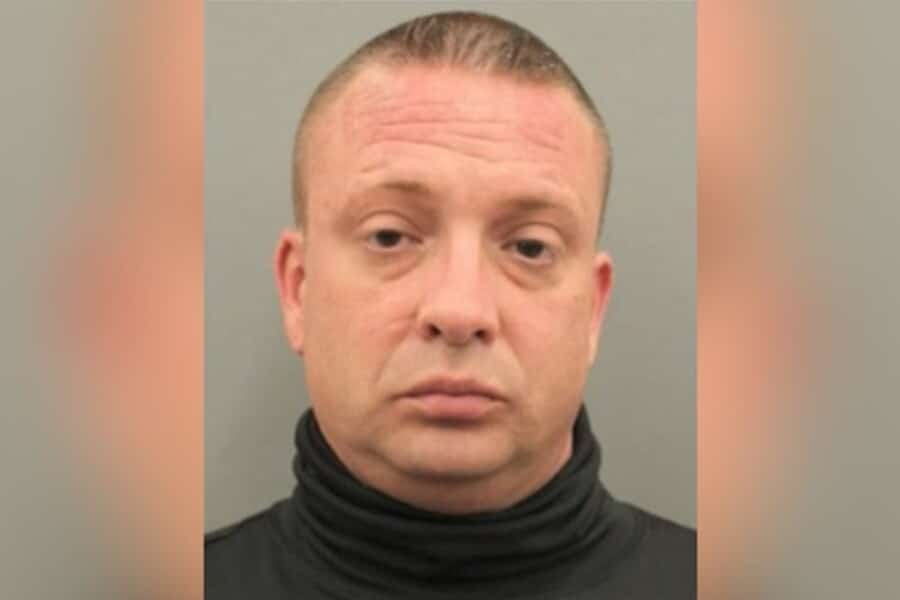
It was a scene scripted for chaos – a street racing event in west Houston descended into confusion as an unauthorized vehicle equipped with flashing emergency lights and blaring sirens attempted to conduct a traffic stop on what appeared to be ordinary vehicles.
But this was no routine law enforcement operation to crack down on the illegal street racers. It was the audacious work of a serial police impersonator looking to exploit the situation for motives still unknown.
The impersonator at the center of the high-risk ruse on Saturday night was identified as 42-year-old Shaun Arnold, a convicted felon with a lengthy rap sheet spanning multiple states and two decades of arrests related to his obsession with posing as a police officer.
This time, Harris County authorities say, Arnold took his impersonation caper to brazen new heights by fully outfitting himself with an array of authentic-looking police gear and equipment.
According to the Harris County Sheriff’s Office, it was around 8 p.m. when undercover deputies monitoring the illegal street racing event first spotted Arnold’s white Hyundai Santa Fe blazing through the area, its rooftop light bar flashing red and blue emergency lights.
As the menacing whir of the vehicle’s sirens pierced through the air, witnesses say Arnold appeared to be attempting to conduct a traffic stop by pulling over what he believed were merely spectators to the street race.
But the quick-thinking undercover deputies recognized something wasn’t quite right with this supposed law enforcement vehicle and its lone operator. Their suspicions aroused, and they promptly alerted marked sheriff’s units to initiate a traffic stop on the suspicious white Hyundai before the situation could escalate any further.
Within minutes, deputies had cornered Arnold’s vehicle, making a startling discovery that laid bare the sheer brazenness and attention to detail of his impersonation efforts.
Decked out head-to-toe in a full police uniform, Arnold was “fully equipped to deceive” with an official-looking police shirt, a bulletproof vest bearing his last name sewn onto the front panel, a utility belt, body-worn camera, and a security badge, authorities said.
But the costume accessories extended well beyond just the uniform. Deputies also recovered an entire arsenal of law enforcement paraphernalia and weapons from inside Arnold’s vehicle – including a BB gun, Taser, police radios, emergency lighting equipment, and other legitimate gear that would typically only be carried by real cops on duty.
“He had himself rigged out pretty convincingly as a police officer,” said a Harris County sheriff’s deputy on the scene. “It’s deeply concerning to see someone willing to go to such extreme lengths to impersonate law enforcement like this.”
For the Harris County Sheriff’s Office, Arnold’s impersonation antics were dishearteningly familiar based on his extensive criminal history. Court records show the Texas man had previously been convicted three times of charges related to impersonating police – in 2001 in Jefferson County, Texas, in 2002 in Illinois, and again in 2015 in Missouri.
Arnold is also a convicted felon, having been found guilty of vehicle theft and larceny, particularly from offenses committed in Missouri dating back over 20 years. Investigators are still looking into what motivated his latest attempt to pose as an on-duty police officer by interrupting the street racing event, and whether he had any other illicit intentions.
In the aftermath of the incident, the Harris County District Attorney’s Office charged Arnold with impersonating a public servant and unlawful possession of body armor as a convicted felon. At his arraignment hearing, a judge set Arnold’s total bond amount at $15,000.
“Police impersonation cases are taken extremely seriously because they represent a violation of the public’s trust,” the district attorney said. “When criminals portray themselves as legitimate law enforcement officers, it can easily create an extremely dangerous situation for all involved.”
The prosecutor noted the intense coordination required between the undercover deputies and marked units to quickly defuse and detain the impersonator demonstrated how integral solid police work is to maintaining public safety.
While the investigation remains ongoing, the incident has raised new concerns over the apparent hallmarks of professionalism that went into Arnold’s impersonation efforts this time around, from his elaborate uniform and gear down to the vehicle’s mounted emergency lighting and siren systems.
Some security experts have cautioned that cases like Arnold’s highlight a vulnerability surrounding the unregulated ability for members of the public to easily purchase police accessories and equipment from online or third-party retailers, with no verification required.
They argue it becomes that much easier for impersonators to circumvent security protocols by passing themselves off as legitimate first responders during emergencies or high-profile events.
As Arnold awaits his next court appearance, police impersonation cases like his also serve as a sobering reminder of how realistic some cons can appear, and the need for the public to remain vigilant about demanding proper credentials before ever complying with someone’s attempt to assert legal authority in the community.





